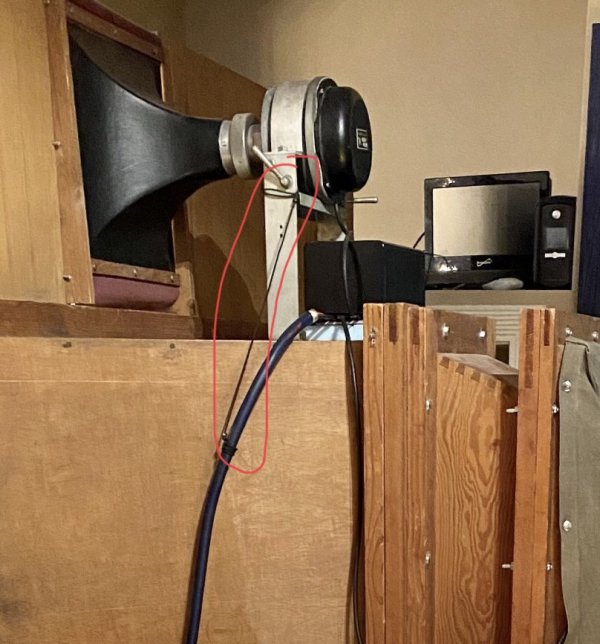Just can't let the politics go eh?Utah’s an open and free state with none of the ridiculous mandates where we are!
david
David Karmeli's Natural Sound in Utah
- Thread starter PeterA
- Start date
You are using an out of date browser. It may not display this or other websites correctly.
You should upgrade or use an alternative browser.
You should upgrade or use an alternative browser.
Well ... Not entirely free. https://taxfoundation.org/state/utah/Utah’s an open and free state with none of the ridiculous mandates where we are!
david
Actually Keith it’s politics that won’t let go of us, your remark comes from yours. My comment was purely informational for both the worried people who want restrictions and those who don’t care for them.Just can't let the politics go eh?
david
Well ... Not entirely free. https://taxfoundation.org/state/utah/
david
! I wish it was but you know that’s not the free I meant.
david
David those two definitions of "free" always go hand in hand. But yes, I'm pretty much pulling your leg.
Brian.
You don’t have a clue about my politics, that’s the point. I’m not sure why your care to share yours so often here.Actually Keith it’s politics that won’t let go of us, your remark comes from yours. My comment was purely informational for both the worried people who want restrictions and those who don’t care for them.
david
! I wish it was but you know that’s not the free I meant.
david
Not that I care but this isn’t our first antagonistic exchange and you are pretty transparent.You don’t have a clue about my politics, that’s the point. I’m not sure why your care to share yours so often here.
david
Last edited:
I first visited David in February of 2021. I am now flying home after a second visit, fourteen months later. As expected, I heard some new speakers and learned more about David’s Natural Sound in Utah. I also had the great pleasure of meeting fellow member and reviewer, Tima. I am still gathering my thoughts and will likely share some impressions of what we heard over the next few days.
Below are photos of the four horn speakers Tima and I heard:
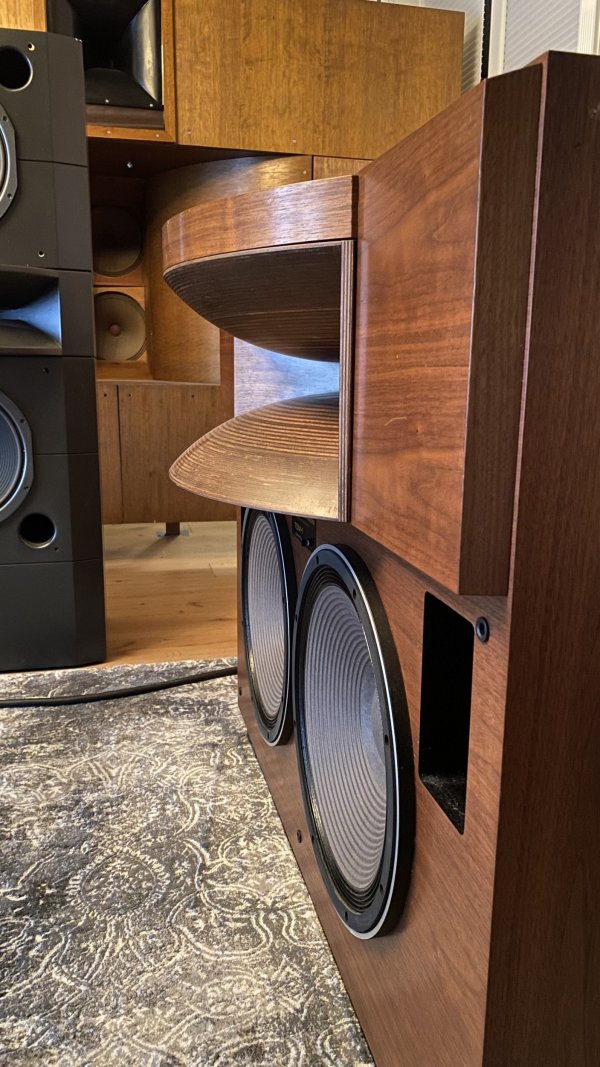
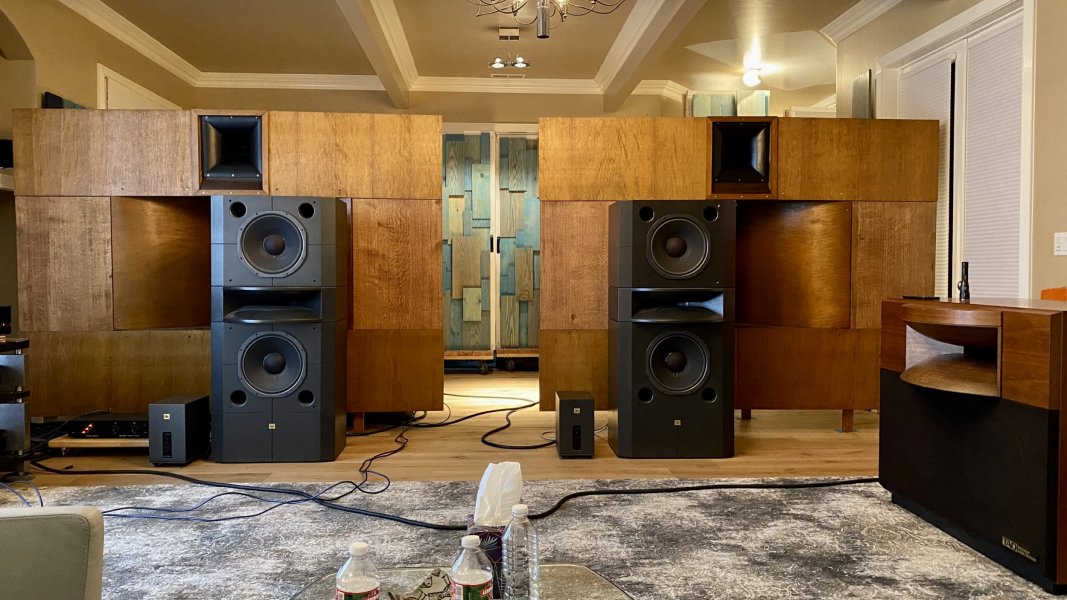
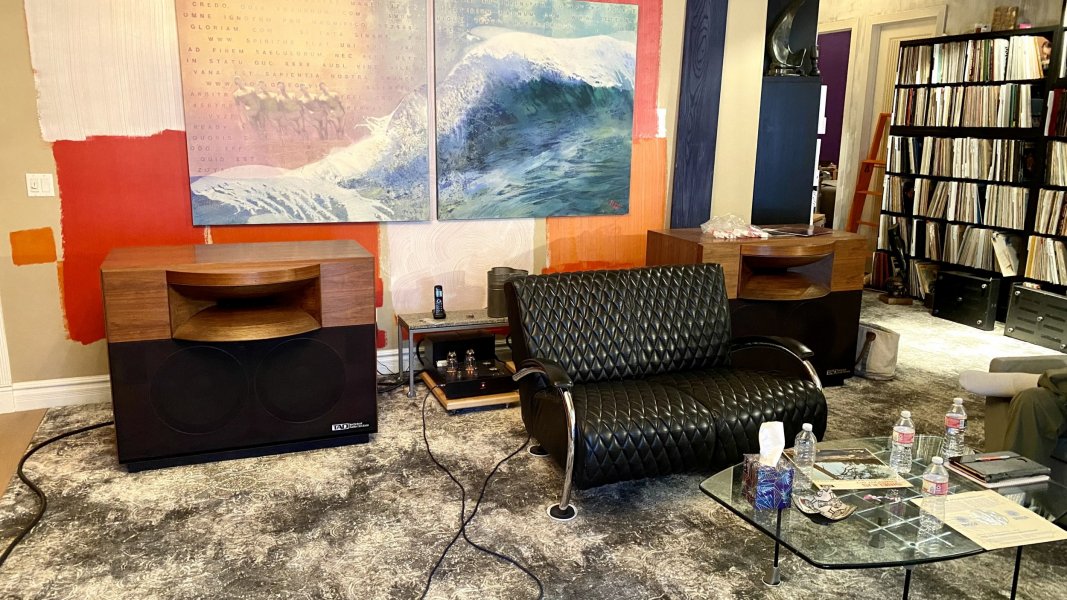
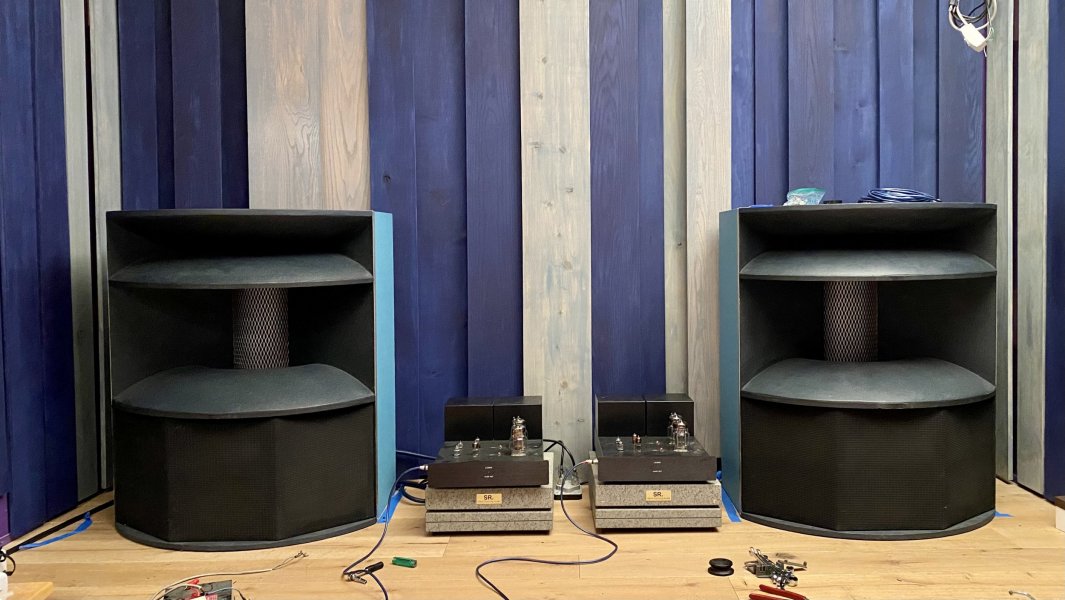
Below are photos of the four horn speakers Tima and I heard:




Last edited:
Steve Williams
Site Founder, Site Co-Owner, Administrator
On my first visit I heard four different systems in two rooms. On this second visit I heard two new speaker systems plus the JBL M9500s moved and set up in the big room in front of the Bionors. This makes a total of six different systems plus the JBL‘s in two different rooms. Not only are the speakers different in these various systems, but I also listened to four turntables, a CD player, four or five cartridges, different cables, and a variety of LAMM solid-state and tube electronics. The main system with the Bionor speakers, the American Sound AS 2000 turntable, and the Lamm Signature series electronics, is a permanent fixture in the room, and it remains the best system I have heard. It is my reference for what is possible.
I learned a few new things during this visit. The first, and perhaps most important, is that despite the convenience of being able to compare the other systems with the main reference system, I thought more about real live music, and the specific recording, than I did about the systems themselves. Each time I sat down to listen to my familiar recordings, I heard the music and not the systems. I found myself listening to the musicians’ performances rather than the cool gear. The presentations of the various systems and how they differed, was secondary. Only when Tim and I discussed the specific differences between components, did I think in analytical terms.
The main conclusion from this trip is that all seven systems sound natural and fundamentally different from other system I have heard. They all share the characteristics I described at the beginning of the thread. They present the music on the recording and do not draw attention to themselves. They sound fundamental right and all sound natural in varying degrees.
Regardless of the room, the vinyl or digital source, the solid-state or tube electronics, they are about presenting the music in a believable and convincing way. I have never been to a dealership where every system follows the same approach. Everything we heard sounded natural. The only difference was by degree. Some speaker systems were slightly more extended, while others were slightly larger in scale or varied slightly in nuance. Some have just a touch more magic, but they all deliver the same message: it’s all about the music.
I will be more detailed about what I heard from some of the systems and specific music in a later post.
I learned a few new things during this visit. The first, and perhaps most important, is that despite the convenience of being able to compare the other systems with the main reference system, I thought more about real live music, and the specific recording, than I did about the systems themselves. Each time I sat down to listen to my familiar recordings, I heard the music and not the systems. I found myself listening to the musicians’ performances rather than the cool gear. The presentations of the various systems and how they differed, was secondary. Only when Tim and I discussed the specific differences between components, did I think in analytical terms.
The main conclusion from this trip is that all seven systems sound natural and fundamentally different from other system I have heard. They all share the characteristics I described at the beginning of the thread. They present the music on the recording and do not draw attention to themselves. They sound fundamental right and all sound natural in varying degrees.
Regardless of the room, the vinyl or digital source, the solid-state or tube electronics, they are about presenting the music in a believable and convincing way. I have never been to a dealership where every system follows the same approach. Everything we heard sounded natural. The only difference was by degree. Some speaker systems were slightly more extended, while others were slightly larger in scale or varied slightly in nuance. Some have just a touch more magic, but they all deliver the same message: it’s all about the music.
I will be more detailed about what I heard from some of the systems and specific music in a later post.
Why are the Bionors covered
We moved those JBL M9500s In front of the Bionors so that we could hear them in the big room with both the ML2s and M1.1 amplifiers. We did not cover the big horns. Note the dolly on the photo. The speakers are so heavy that we had to take apart all three sections to get it off the dolly and reassemble it in front of the Bionors.
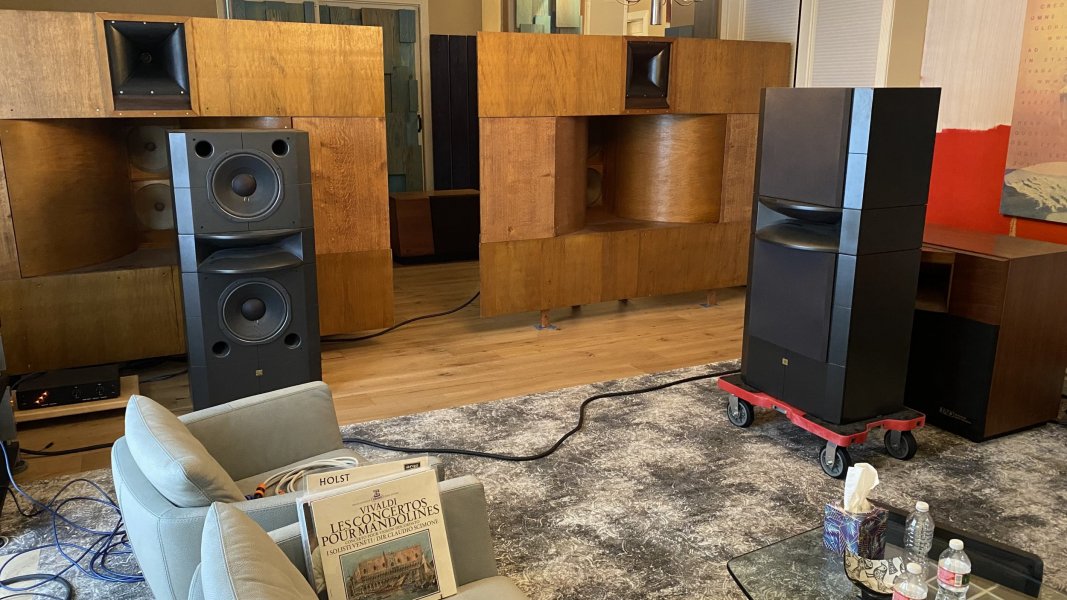
The LAMM ML3 amplifiers in the distance with the power supplies in the foreground. These drive the mighty Bionor Speakers. Note the wire spaghetti on the floor. Contrary to conventional wisdom, the messy wires don’t seem to affect the sound. It’s all set up for flexibility and ability to easily switch components.
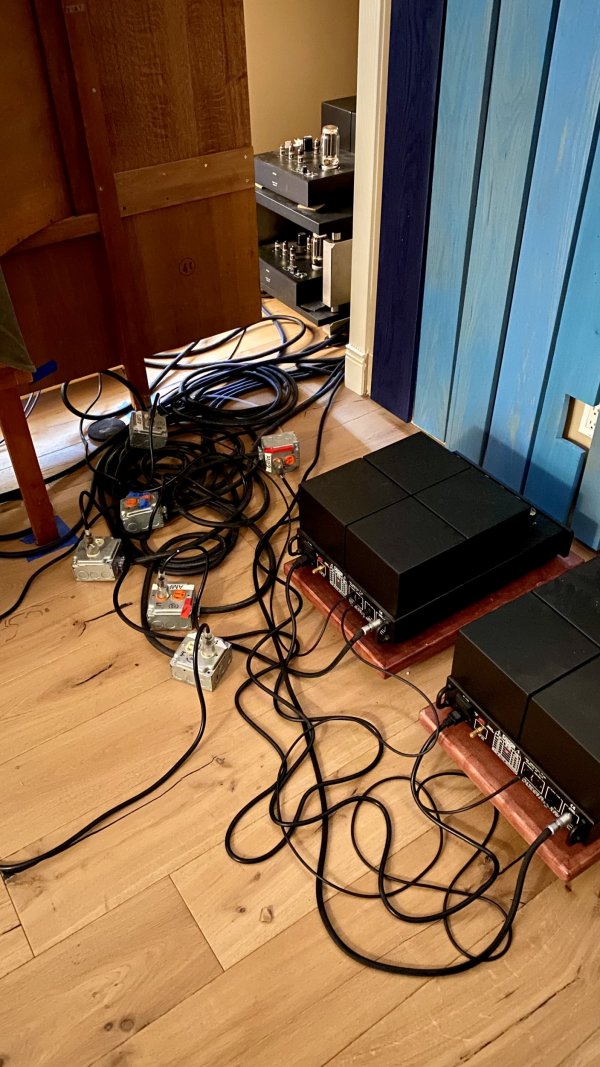
Here are the LAMM ML2 SET amps on David’s two tier Nothing Rack for amps usually used to drive his JBL 18 inch vintage subwoofers. We disconnected them and hooked them up to the JBL M9500s for the demo. Note the wires all around for gear swapping. The amp rack is extremely heavy and sturdy. I’ve never seen anything like it.
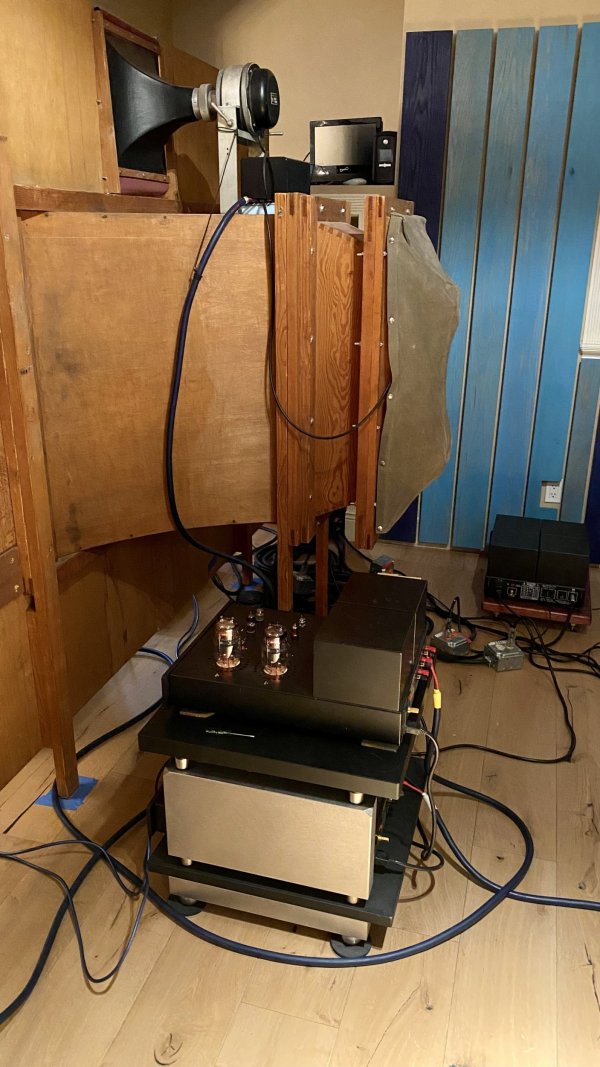

Here are the LAMM ML2 SET amps on David’s two tier Nothing Rack for amps usually used to drive his JBL 18 inch vintage subwoofers. We disconnected them and hooked them up to the JBL M9500s for the demo. Note the wires all around for gear swapping. The amp rack is extremely heavy and sturdy. I’ve never seen anything like it.

David’s second, smaller room has changed quite a bit since I was last here. He has worked on the acoustics by constructing a front wall of wooden diffusers. In this room is a pair of vintage RCA theater horns, original LAMM LP2, L2, and ML2 electronics, and a one-of-a-kind prototype turntable of extremely high mass. Note the huge platter relative to the LP. It has an air bearing and thread drive.
The room sounded much better than I remember it a year ago. The front wall treatment has made a big difference, but I think there is still work to be done. David is still working on the system, but it sounded excellent.
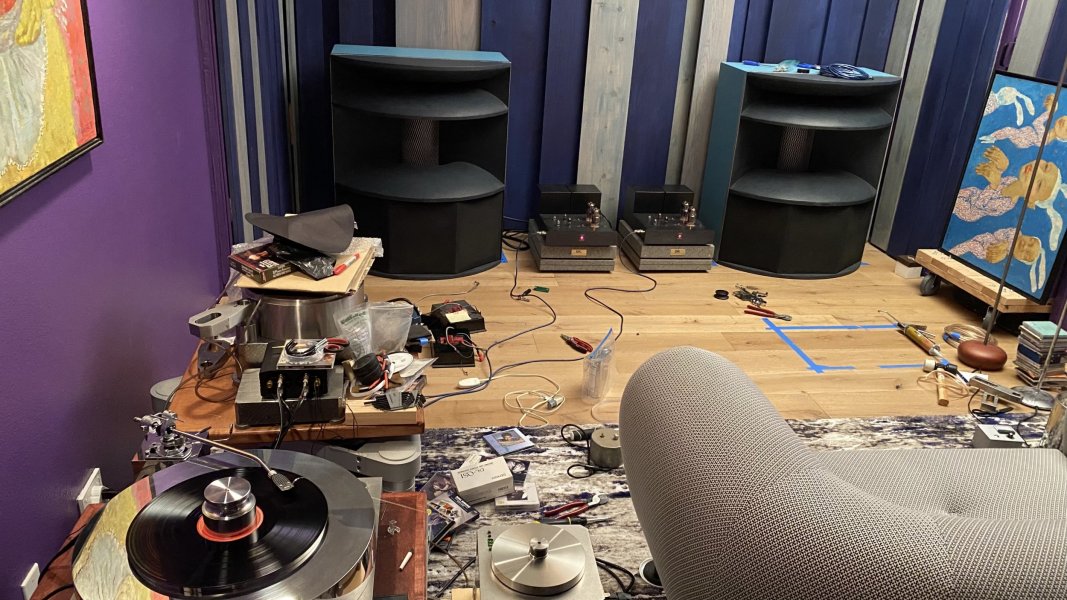
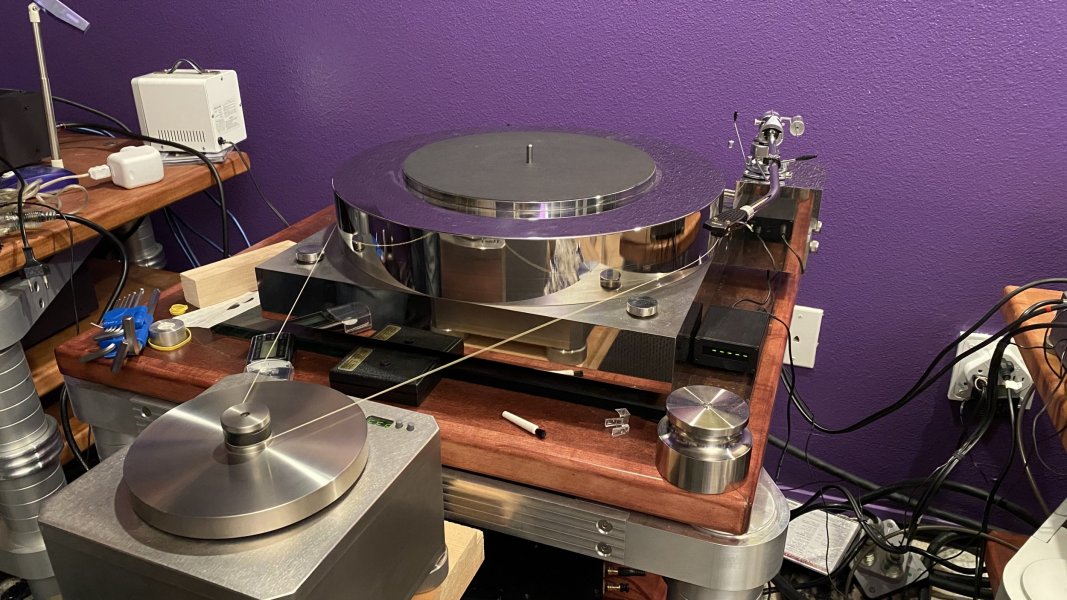
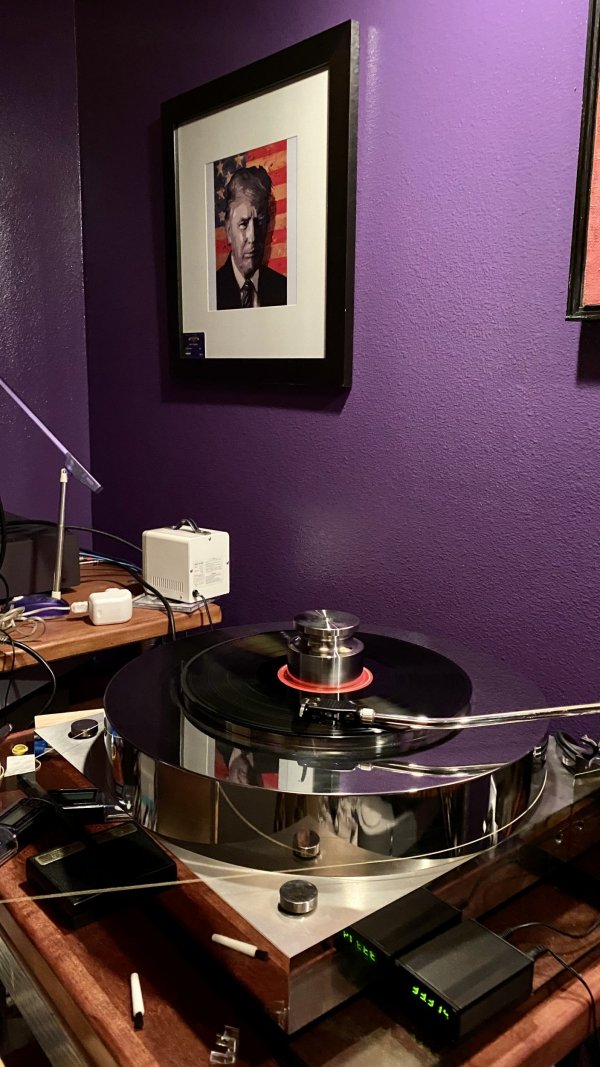
The room sounded much better than I remember it a year ago. The front wall treatment has made a big difference, but I think there is still work to be done. David is still working on the system, but it sounded excellent.



Last edited:
I think my arms are to short to flip the records on that TT !
On the drive to the airport, David asked me if I learned anything from this trip. It’s an interesting question. The first time I came, I wanted to meet David and check out the new turntable I had ordered. I also wanted to hear his big system. I left that visit with a completely new understanding of what was possible with an audio system. Everything was new to me then, and I was quite overwhelmed by the experience. It resulted in a completely new system.
I have lived with that new system for a year now. As it has settled, and I have acclimated to the sound, I continue to appreciate just how different it is from what I had. I also get new insights to my music collection. I am upgrading my power delivery and the system continues to improve. I arrived at David‘s house with a better appreciation of what a system can do and I have become a better listener.
I enjoy reading Karen Sumner’s various essays on the forum, particularly most recent one about Space: the Final Frontier. I told David and Tim that during this visit, I gained a better appreciation for and understanding of the portrayal of space from David’s systems.
David’s big system is simply astonishing in the way the ambience from the recording is presented. I brought Arthur Grumiaux’s recording of Beethoven’s Violin Concerto on Phillips. The large space between the plane of the speakers and the front wall was completely filled by the orchestra. Grumiaux was front and center playing his violin. The timpani was far back behind him. The string sections were to either side and the brass and woodwinds were in the middle. The stage was vast and layered. The musicians were well located within the space and there was a sense of the boundaries. The energy from the instruments expended outward in all directions and filled the room completely. The massive speakers disappeared. It was as though we were seated in the middle of the orchestra section, back about fifteen rows.
David later played an Ella Fitzgerald and Joe Pass recording on Pablo. We were suddenly transported to the jazz club or café with Ella right there in the room and Joe Pass seated on a stool next to her. Closing my eyes, I was in the room with them. Jim Smith refers to this as presence. Karen Sumner calls it space. David refers to it as ambience. Whatever you wanna call it, it is that quality which makes you believe you are in the presence of the musicians occupying the space and understanding the ambience of the setting. Tim refers to this as the context of the performance. David’s big system and the JBL have it in spades.
The next day I played a recording of Peter Schreier singing Winterreisse. This was on the JBLs. The volume was a little bit too high, so I turned it down and then suddenly everything clicked and he was singing right in front of the piano just behind the speakers. There was no pinpoint imaging, there was no black background, there were no stark outlines. There was just the energy of the performers up there in space in front of us. I heard his performance with Al M and my father a few years ago. My memory is strong and the illusion at David’s was utterly convincing. I now better understand why Karen Sumner refers to space as the “final frontier”.
The information is all on the recording. The challenge is to find the components that can deliver it and set it up in a way that you don’t corrupt it and lose it. All of David systems present space well. Some of them do it extraordinarily well. After the tone and dynamics are right, the ambience is the final piece that makes you believe you’re there with the musicians.
EDIT: I don’t think this sense of ambience from a system is achievable separately from tone and dynamics. I have to think about this a little bit more, but my suspicion is that it basically comes down to resolution being presented naturally, and if you get one you get all three for a complete and holistic listening experience, just like at the concert hall. These qualities are interrelated and cannot be separated from each other.
I have lived with that new system for a year now. As it has settled, and I have acclimated to the sound, I continue to appreciate just how different it is from what I had. I also get new insights to my music collection. I am upgrading my power delivery and the system continues to improve. I arrived at David‘s house with a better appreciation of what a system can do and I have become a better listener.
I enjoy reading Karen Sumner’s various essays on the forum, particularly most recent one about Space: the Final Frontier. I told David and Tim that during this visit, I gained a better appreciation for and understanding of the portrayal of space from David’s systems.
David’s big system is simply astonishing in the way the ambience from the recording is presented. I brought Arthur Grumiaux’s recording of Beethoven’s Violin Concerto on Phillips. The large space between the plane of the speakers and the front wall was completely filled by the orchestra. Grumiaux was front and center playing his violin. The timpani was far back behind him. The string sections were to either side and the brass and woodwinds were in the middle. The stage was vast and layered. The musicians were well located within the space and there was a sense of the boundaries. The energy from the instruments expended outward in all directions and filled the room completely. The massive speakers disappeared. It was as though we were seated in the middle of the orchestra section, back about fifteen rows.
David later played an Ella Fitzgerald and Joe Pass recording on Pablo. We were suddenly transported to the jazz club or café with Ella right there in the room and Joe Pass seated on a stool next to her. Closing my eyes, I was in the room with them. Jim Smith refers to this as presence. Karen Sumner calls it space. David refers to it as ambience. Whatever you wanna call it, it is that quality which makes you believe you are in the presence of the musicians occupying the space and understanding the ambience of the setting. Tim refers to this as the context of the performance. David’s big system and the JBL have it in spades.
The next day I played a recording of Peter Schreier singing Winterreisse. This was on the JBLs. The volume was a little bit too high, so I turned it down and then suddenly everything clicked and he was singing right in front of the piano just behind the speakers. There was no pinpoint imaging, there was no black background, there were no stark outlines. There was just the energy of the performers up there in space in front of us. I heard his performance with Al M and my father a few years ago. My memory is strong and the illusion at David’s was utterly convincing. I now better understand why Karen Sumner refers to space as the “final frontier”.
The information is all on the recording. The challenge is to find the components that can deliver it and set it up in a way that you don’t corrupt it and lose it. All of David systems present space well. Some of them do it extraordinarily well. After the tone and dynamics are right, the ambience is the final piece that makes you believe you’re there with the musicians.
EDIT: I don’t think this sense of ambience from a system is achievable separately from tone and dynamics. I have to think about this a little bit more, but my suspicion is that it basically comes down to resolution being presented naturally, and if you get one you get all three for a complete and holistic listening experience, just like at the concert hall. These qualities are interrelated and cannot be separated from each other.
Last edited:
A lot of those speakers look like 2 x 15" woofers in a ported box and a horn. Much like my PAP Trio 15. Accept my woofers are open baffle.
What do you think the sealed woofers bring compared to open.
Unfortunately, I have never heard your speakers so I do not know how they compare to the enclosed woofers designs.
So you and Tima are the ones who hold up my Eurodyn.On the drive to the airport, David asked me if I learned anything from this trip. It’s an interesting question. The first time I came, I wanted to meet David and check out the new turntable I had ordered. I also wanted to hear his big system. I left that visit with a completely new understanding of what was possible with an audio system. Everything was new to me then, and I was quite overwhelmed by the experience. It resulted in a completely new system.
I have lived with that new system for a year now. As it has settled, and I have acclimated to the sound, I continue to appreciate just how different it is from what I had. I also get new insights to my music collection. I am upgrading my power delivery and the system continues to improve. I arrived at David‘s house with a better appreciation of what a system can do and I have become a better listener.
I enjoy reading Karen Sumner’s various essays on the forum, particularly most recent one about Space: the Final Frontier. I told David and Tim that during this visit, I gained a better appreciation for and understanding of the portrayal of space from David’s systems.
David’s big system is simply astonishing in the way the ambience from the recording is presented. I brought Arthur Grumiaux’s recording of Beethoven’s Violin Concerto on Phillips. The large space between the plane of the speakers and the front wall was completely filled by the orchestra. Grumiaux was front and center playing his violin. The timpani was far back behind him. The string sections were to either side and the brass and woodwinds were in the middle. The stage was vast and layered. The musicians were well located within the space and there was a sense of the boundaries. The energy from the instruments expended outward in all directions and filled the room completely. The massive speakers disappeared. It was as though we were seated in the middle of the orchestra section, back about fifteen rows.
David later played an Ella Fitzgerald and Joe Pass recording on Pablo. We were suddenly transported to the jazz club or café with Ella right there in the room and Joe Pass seated on a stool next to her. Closing my eyes, I was in the room with them. Jim Smith refers to this as presence. Karen Sumner calls it space. David refers to it as ambience. Whatever you wanna call it, it is that quality which makes you believe you are in the presence of the musicians occupying the space and understanding the ambience of the setting. Tim refers to this as the context of the performance. David’s big system and the JBL have it in spades.
The next day I played a recording of Peter Schreier singing Winterreisse. This was on the JBLs. The volume was a little bit too high, so I turned it down and then suddenly everything clicked and he was singing right in front of the piano just behind the speakers. There was no pinpoint imaging, there was no black background, there were no stark outlines. There was just the energy of the performers up there in space in front of us. I heard his performance with Al M and my father a few years ago. My memory is strong and the illusion at David’s was utterly convincing. I now better understand why Karen Sumner refers to space as the “final frontier”.
The information is all on the recording. The challenge is to find the components that can deliver it and set it up in a way that you don’t corrupt it and lose it. All of David systems present space well. Some of them do it extraordinarily well. After the tone and dynamics are right, the ambience is the final piece that makes you believe you’re there with the musicians.
EDIT: I don’t think this sense of ambience from a system is achievable separately from tone and dynamics. I have to think about this a little bit more, but my suspicion is that it basically comes down to resolution being presented naturally, and if you get one you get all three for a complete and holistic listening experience, just like at the concert hall. These qualities are interrelated and cannot be separated from each other.
Similar threads
- Replies
- 1
- Views
- 644
- Replies
- 0
- Views
- 658
- Replies
- 11
- Views
- 2K
- Replies
- 2
- Views
- 970
- Replies
- 7
- Views
- 515
| Steve Williams Site Founder | Site Owner | Administrator | Ron Resnick Site Owner | Administrator | Julian (The Fixer) Website Build | Marketing Managersing |







